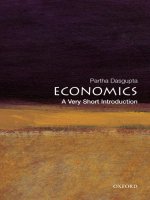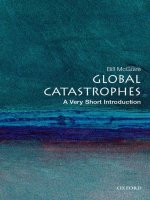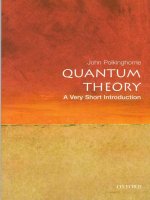Tragedy a very short introduction
Bạn đang xem bản rút gọn của tài liệu. Xem và tải ngay bản đầy đủ của tài liệu tại đây (2.17 MB, 161 trang )
Tai Lieu Chat Luong
Tragedy: A Very Short Introduction
Very Short Introductions are for anyone wanting a stimulating
and accessible way in to a new subject. They are written by experts, and have
been published in more than 25 languages worldwide.
The series began in 1995, and now represents a wide variety of topics
in history, philosophy, religion, science, and the humanities. Over the next
few years it will grow to a library of around 200 volumes – a Very Short
Introduction to everything from ancient Egypt and Indian philosophy to
conceptual art and cosmology.
Very Short Introductions available now:
ANARCHISM Colin Ward
ANCIENT EGYPT Ian Shaw
ANCIENT PHILOSOPHY
Julia Annas
ANCIENT WARFARE
Harry Sidebottom
THE ANGLO-SAXON AGE
John Blair
ANIMAL RIGHTS David DeGrazia
ARCHAEOLOGY Paul Bahn
ARCHITECTURE
Andrew Ballantyne
ARISTOTLE Jonathan Barnes
ART HISTORY Dana Arnold
ART THEORY Cynthia Freeland
THE HISTORY OF
ASTRONOMY Michael Hoskin
Atheism Julian Baggini
Augustine Henry Chadwick
BARTHES Jonathan Culler
THE BIBLE John Riches
BRITISH POLITICS
Anthony Wright
Buddha Michael Carrithers
BUDDHISM Damien Keown
BUDDHIST ETHICS Damien Keown
CAPITALISM James Fulcher
THE CELTS Barry Cunliffe
CHOICE THEORY
Michael Allingham
CHRISTIAN ART Beth Williamson
CHRISTIANITY Linda Woodhead
CLASSICS Mary Beard and
John Henderson
CLAUSEWITZ Michael Howard
THE COLD WAR Robert McMahon
CONSCIOUSNESS Susan Blackmore
Continental Philosophy
Simon Critchley
COSMOLOGY Peter Coles
CRYPTOGRAPHY
Fred Piper and Sean Murphy
DADA AND SURREALISM
David Hopkins
Darwin Jonathan Howard
Democracy Bernard Crick
DESCARTES Tom Sorell
DINOSAURS David Norman
DREAMING J. Allan Hobson
DRUGS Leslie Iversen
THE EARTH Martin Redfern
EGYPTIAN MYTH
Geraldine Pinch
EIGHTEENTH-CENTURY
BRITAIN Paul Langford
THE ELEMENTS Philip Ball
EMOTION Dylan Evans
EMPIRE Stephen Howe
ENGELS Terrell Carver
Ethics Simon Blackburn
The European Union
John Pinder
EVOLUTION
Brian and Deborah Charlesworth
FASCISM Kevin Passmore
FOUCAULT Gary Gutting
THE FRENCH REVOLUTION
William Doyle
FREE WILL Thomas Pink
Freud Anthony Storr
Galileo Stillman Drake
Gandhi Bhikhu Parekh
GLOBALIZATION
Manfred Steger
GLOBAL WARMING Mark Maslin
HABERMAS
James Gordon Finlayson
HEGEL Peter Singer
HEIDEGGER Michael Inwood
HIEROGLYPHS Penelope Wilson
HINDUISM Kim Knott
HISTORY John H. Arnold
HOBBES Richard Tuck
HUME A. J. Ayer
IDEOLOGY Michael Freeden
Indian Philosophy
Sue Hamilton
Intelligence Ian J. Deary
ISLAM Malise Ruthven
JUDAISM Norman Solomon
Jung Anthony Stevens
KAFKA Ritchie Robertson
KANT Roger Scruton
KIERKEGAARD Patrick Gardiner
THE KORAN Michael Cook
LINGUISTICS Peter Matthews
LITERARY THEORY
Jonathan Culler
LOCKE John Dunn
LOGIC Graham Priest
MACHIAVELLI Quentin Skinner
THE MARQUIS DE SADE
John Phillips
MARX Peter Singer
MATHEMATICS Timothy Gowers
MEDICAL ETHICS Tony Hope
MEDIEVAL BRITAIN
John Gillingham and Ralph A. Griffiths
MODERN ART David Cottington
MODERN IRELAND Senia Pasˇeta
MOLECULES Philip Ball
MUSIC Nicholas Cook
Myth Robert A. Segal
NIETZSCHE Michael Tanner
NINETEENTH-CENTURY
BRITAIN Christopher Harvie and
H. C. G. Matthew
NORTHERN IRELAND
Marc Mulholland
PARTICLE PHYSICS Frank Close
paul E. P. Sanders
Philosophy Edward Craig
PHILOSOPHY OF SCIENCE
Samir Okasha
PLATO Julia Annas
POLITICS Kenneth Minogue
POLITICAL PHILOSOPHY
David Miller
POSTCOLONIALISM
Robert Young
POSTMODERNISM
Christopher Butler
POSTSTRUCTURALISM
Catherine Belsey
PREHISTORY Chris Gosden
PRESOCRATIC PHILOSOPHY
Catherine Osborne
Psychology Gillian Butler and
Freda McManus
QUANTUM THEORY
John Polkinghorne
RENAISSANCE ART
Geraldine A. Johnson
ROMAN BRITAIN Peter Salway
ROUSSEAU Robert Wokler
RUSSELL A. C. Grayling
RUSSIAN LITERATURE
Catriona Kelly
THE RUSSIAN REVOLUTION
S. A. Smith
SCHIZOPHRENIA
Chris Frith and Eve Johnstone
SCHOPENHAUER
Christopher Janaway
SHAKESPEARE Germaine Greer
SIKHISM Eleanor Nesbitt
SOCIAL AND CULTURAL
ANTHROPOLOGY
John Monaghan and Peter Just
SOCIALISM Michael Newman
SOCIOLOGY Steve Bruce
Socrates C. C. W. Taylor
THE SPANISH CIVIL WAR
Helen Graham
SPINOZA Roger Scruton
STUART BRITAIN John Morrill
TERRORISM Charles Townshend
THEOLOGY David F. Ford
THE HISTORY OF TIME
Leofranc Holford-Strevens
TRAGEDY
Adrian Poole
THE TUDORS John Guy
TWENTIETH-CENTURY
BRITAIN Kenneth O. Morgan
Wittgenstein A. C. Grayling
WORLD MUSIC Philip Bohlman
THE WORLD TRADE
ORGANIZATION
Amrita Narlikar
Available soon:
AFRICAN HISTORY
John Parker and Richard Rathbone
THE BRAIN Michael O’Shea
CHAOS Leonard Smith
CITIZENSHIP Richard Bellamy
CLASSICAL ARCHITECTURE
Robert Tavernor
CONTEMPORARY ART
Julian Stallabrass
THE CRUSADES
Christopher Tyerman
THE DEAD SEA SCROLLS
Timothy Lim
Derrida Simon Glendinning
DESIGN John Heskett
ECONOMICS Partha Dasgupta
THE END OF THE WORLD
Bill McGuire
EXISTENTIALISM Thomas Flynn
FEMINISM Margaret Walters
THE FIRST WORLD WAR
Michael Howard
FOSSILS Keith Thomson
FUNDAMENTALISM
Malise Ruthven
HUMAN EVOLUTION
Bernard Wood
INTERNATIONAL RELATIONS
Paul Wilkinson
JAZZ Brian Morton
JOURNALISM Ian Hargreaves
MANDELA Tom Lodge
THE MIND Martin Davies
NATIONALISM Steven Grosby
PERCEPTION Richard Gregory
PHILOSOPHY OF RELIGION
Jack Copeland and Diane Proudfoot
PHOTOGRAPHY Steve Edwards
RACISM Ali Rattansi
THE RAJ Denis Judd
THE RENAISSANCE
Jerry Brotton
ROMAN EMPIRE
Christopher Kelly
SARTRE Christina Howells
THE VIKINGS Julian D. Richards
For more information visit our web site
www.oup.co.uk/vsi/
Adrian Poole
Tragedy
A Very Short Introduction
1
3
Great Clarendon Street, Oxford o x 2 6 d p
Oxford University Press is a department of the University of Oxford.
It furthers the University’s objective of excellence in research, scholarship,
and education by publishing worldwide in
Oxford New York
Auckland Cape Town Dar es Salaam Hong Kong Karachi
Kuala Lumpur Madrid Melbourne Mexico City Nairobi
New Delhi Shanghai Taipei Toronto
With offices in
Argentina Austria Brazil Chile Czech Republic France Greece
Guatemala Hungary Italy Japan Poland Portugal Singapore
South Korea Switzerland Thailand Turkey Ukraine Vietnam
Oxford is a registered trade mark of Oxford University Press
in the UK and in certain other countries
Published in the United States
by Oxford University Press Inc., New York
© Adrian Poole 2005
The moral rights of the author have been asserted
Database right Oxford University Press (maker)
First published as a Very Short Introduction 2005
All rights reserved. No part of this publication may be reproduced,
stored in a retrieval system, or transmitted, in any form or by any means,
without the prior permission in writing of Oxford University Press,
or as expressly permitted by law, or under terms agreed with the appropriate
reprographics rights organizations. Enquiries concerning reproduction
outside the scope of the above should be sent to the Rights Department,
Oxford University Press, at the address above
You must not circulate this book in any other binding or cover
and you must impose this same condition on any acquirer
British Library Cataloguing in Publication Data
Data available
Library of Congress Cataloging in Publication Data
Data available
ISBN 0–19–280235–6
EAN 978–0–19–280235–4
1 3 5 7 9 10 8 6 4 2
Typeset by RefineCatch Ltd, Bungay, Suffolk
Printed in Great Britain by
TJ International Ltd., Padstow, Cornwall
Contents
Acknowledgements ix
List of illustrations xi
Introduction
1
2
3
4
5
6
7
8
9
1
Who needs it?
3
Once upon a time
The living dead
20
33
Who’s to blame? 44
Big ideas 56
No laughing matter 69
Words, words, words
Timing
97
Endings
References
112
125
Further reading
Index 141
132
82
This page intentionally left blank
Acknowledgements
I owe a debt to the numerous students and colleagues with whom I have
discussed tragedy over many years at Cambridge. I am also grateful for
recent specific advice and suggestions to Anne Barton, Jonathan Bate,
Ian Donaldson, Robert Douglas-Fairhurst, Kelvin Everest, Tamara
Follini, Gérald Garutti, Simon James, Jessica Martin, Drew Milne, and
most of all to Margaret de Vaux. I must thank George Miller for the
original invitation to contribute this volume to the series, Emily Jolliffe,
Becky O’Connor, and Emma Simmons for their assistance and
encouragement en route, and my editors Marsha Filion and James
Thompson for seeing the work through its final stages. I am gratefully
conscious of the generous support I have enjoyed from the award of a
British Academy Readership for a larger project on witnessing tragedy,
without which this short book would have been even longer in reaching
completion.
This page intentionally left blank
List of illustrations
1
Cartoon by J. C. Duffy,
from The New Yorker,
12 May 2003
6
© The New Yorker Collection
2003/J. C. Duffy from
cartoonbank.com. All rights
reserved
2 Oswaldo Tofani, A Tragic
Duel: The Death of
Monsieur Harry Alis,
from Le Petit Journal,
17 March 1895
8
Private collection/Giraudon/
www.bridgeman.co.uk
3 Anon. (French School),
‘Boethius with the
Wheel of Fortune’,
15th century
9
Bibliothèque Municipale, Rouen/
Giraudon/www.bridgeman.co.uk
4 Cartoon by Bronstrup,
first published San
Francisco Post, 1913
10
San Francisco Post, 1913
5 Statue of Melpomene,
detail of head,
c. 476 bc
11
Vatican Museums and Galleries/
Alinari Archives, Florence
6 Gustav Klimt, Tragoedie,
1897
12
Historisches Museum der Stadt,
Vienna/www.bridgeman.co.uk
7 Tarentine red-figure
krater showing death of
Hippolytus, attributed to
the Darius Painter, late
4th century bc
24
© The Trustees of The British
Museum
8 Attic red-figure
calyx-krater showing the
death of Agamemnon,
attributed to the
Dokimasia Painter
25
Museum of Fine Arts, Boston
(63.1246). Reproduced with
permission. © 2005 Museum
of Fine Arts, Boston. All rights
reserved
9 Jacques Louis David,
Lictors Bearing to Brutus
the Bodies of his Sons,
1789
60
14
National Archaeological Museum,
Athens/akg-images/Nimatallah
Louvre, Paris/Photos12.com/
Oasis
15
10
Titian, The Flaying of
Marsyas, c. 1570–75 67
James Gillray, ‘A Parody
of Macbeth’s Soliloquy at
Covent Garden Theatre’,
1809 Covent Garden
Opera House
Collection
71
Covent Garden Opera House
Collection, London/
www.bridgeman.co.uk
12
Franỗois Chauveau, The
Death of Britannicus,
1669, from Britannicus by
Jean Racine
89
Ernst Barlach, The
Terrible Year, 1936
101
© Ernst Barlach
Lizenzverwaltung, Ratzeburg.
Private collection/
www.bridgeman.co.uk
Erzbischoefliches Schloss,
Kromeriz/akg-images
11
The Striding God of
Artemisium, shortly
before 450 bc
100
16
Eugène Delacroix,
Medea, 1838
109
Musée des Beaux-Arts, Lille/
Photos12.com/ARJ
17
Don McCullin, ‘The
mandolin player,
photographed despite a
death threat to the
photographer’
110
© Don McCullin/Contact/nb
pictures
© Gianni Dagli Orti/Corbis
13
Francisco Goya, The
Disasters of War, no. 39:
‘Grande hazan
˜ a! Con
muertos!’ [‘Great deeds!
With the dead!’],
1810–20; first published
1863
95
© Burstein Collection/Corbis
The publisher and the author apologize for any errors or omissions
in the above list. If contacted they will be pleased to rectify these at
the earliest opportunity.
Introduction
Tragedy is a precious word. We use it to confer dignity and value on
violence, catastrophe, agony, and bereavement. ‘Tragedy’ claims that
this death is exceptional. Yet these supposedly special fatalities are
in our ears and eyes every day, on the roads, in the skies, out there in
foreign lands and right here at home, the latest bad news. Is the
word now bandied around so freely that it has lost all meaning? Do
our conceptions of tragedy have any real connection with those of
the ancient Greeks, with whom it originated two and half thousand
years ago as the description of a particular kind of drama? How did
tragedy migrate from the Greeks to Shakespeare and Racine, from
drama to other art forms, from fiction to real events? What needs
has the idea of tragedy served, and to what use and abuse has it
been put?
This Very Short Introduction addresses these questions through a
series of nine topics. Chapter 1 considers the distance between our
modern application of the words ‘tragic’ and ‘tragedy’ and their
origins in 5th-century Athens, including some changing ideas about
fate and accident, the importance of stories and plots, and the
significance of the disagreement between Plato and Aristotle over
tragedy’s claims to truth and its effects on those who witness it. In
Chapter 2 we will look at the possibility that tragedy as a living art
form belongs to the past, to ages when artists and audiences drew
on shared religious beliefs, including beliefs about the meaning of
1
Tragedy
pain and punishment. Chapter 3 suggests that tragedy is an art
particularly concerned with our need to lay the past to rest and the
dangers of failing to do so; hence tragedy’s interest in ghosts and
revenge, in mourning and memory, in the ambivalent models
provided by ‘heroes’. In Chapter 4 we turn our attention to the
questions of blame, responsibility, and guilt, to Aristotle’s notion of
‘error’ and to the process of scapegoating. Chapter 5 describes some
of the big ideas about tragedy that theorists, including the
influential figures of Hegel and Nietzsche, have developed over the
last two hundred years, and the resistance or outright hostility such
ideas have provoked by their contempt for the reality of pain.
Chapter 6 affords some relief by raising the question of comedy in
tragedy, especially the role of scornful laughter, both for characters
within the fiction and for audiences and readers outside it. In
Chapter 7 we consider the importance to tragedy of verbal
eloquence and its frustration; the reticence, stammering, and
silence to which human beings may be reduced and out of which
they can seek to break. Chapter 8 focuses on the different kinds of
time that tragedies bring together: the experience of waiting
‘between times’ and the moment of decisive action when what’s
done is done, conjunctions of past and future in the here and now
that the visual arts are well placed to capture. In conclusion,
Chapter 9 turns to the problem of endings in tragedy, and the
complex desires for justice and truth that they excite in those who
witness it.
Who needs tragedy? Can we imagine a world without tragedy?
Would we want to? These are some of the tough questions that the
art of tragedy puts into words and images, so tellingly – at least in
the hands of its greatest exponents – that it seems we can’t do
without it.
2
Chapter 1
Who needs it?
Bad news
Open the paper, turn on the news, and sooner or later you’ll meet
the words ‘tragic’ and ‘tragedy’. Even as I write, 19 Chinese
cockle-pickers are reported drowned in Morecambe Bay,
Lancashire. ‘The gangs behind the tragedy are on the run’, one
headline assures us. The story attracts no fewer than ten more
‘tragedies’ across two reports and a leader in the Guardian
(7 February 2004). Tragedy: how many more times, of how many
more disasters, before you read this? Even as this goes to press, the
number of lives lost to the Asian tsunami and its aftermath appears
literally countless.
It’s easy to feel overwhelmed by the word. Once it meant something
special, as it did to John Milton, writing in the middle of the
17th century:
Sometime let gorgeous Tragedy
In sceptred pall come sweeping by,
Presenting Thebes, or Pelops’ line,
Or the tale of Troy divine.
Or what (though rare) of later age,
Ennobled hath the buskined stage.
3
Tragedy
He is thinking of Tragedy as a regal figure from ancient Greece, like
Oedipus (from Thebes) and Agamemnon (descendant of Pelops)
and the heroes from Homer’s Iliad (the tale of Troy), and he dresses
them up with lofty old words like ‘pall’ (robe) and ‘buskin’ (the high
thick-soled boot supposedly worn by the actors in Athenian
tragedy). It’s a long way from the tale of those Chinese cocklepickers. Nothing gorgeous about them. No sceptred palls or buskins
in evidence, no connection with ancient myth, and not much chance
of dramatic ennobling. For Milton, tragedy was not something that
happens every day. It was an idea attached to a specific form of
drama performed at special times and places, at the religious
festivals of ancient Athens and the courts of modern kings and
noblemen.
Though its origins are shrouded in obscurity, ‘tragedy’ first emerged
into the light in Athens around 533 bc with the actor Thespis (from
whom we get ‘thespian’). It enjoyed a long high noon through the
following century, from which a handful of masterpieces have
survived in their entirety, seven attributed to Aeschylus, seven to
Sophocles, and 19 to Euripides, the great trio of playwrights
of whom we shall hear more throughout this book. We have
fragments, titles, and reports of many more – Sophocles alone is
said to have composed 130 – and it’s sobering to realize what a
small fraction has come down to us. The honour of having their
work performed at the Festival of the Great Dionysia was restricted
to three dramatists selected to compete for the prize of ‘best
tragic poet’. Each had to supply three tragedies and a satyr play,
a grotesquely comic after-piece featuring a chorus of satyrs
(half-man and half-beast), of which only one complete example,
the Cyclops of Euripides, has survived. There were other
competitions for comedy and dithyramb (a form of choral song).
Special occasions, special people: tragedy portrayed the fate of
famous men and women – legends such as Oedipus and Medea – in
elevated style and language. Not of nobodies like you or me, let
alone Chinese cockle-pickers, who could have hoped at best for a
4
walk-on part as slaves or messengers. Yet before we succumb to
nostalgia, we should note that Milton himself had to defend tragedy
from ‘the small esteem, or rather infamy’ into which it had fallen in
his day. Like other neoclassical writers, Milton deplored the way
modern authors had mixed up tragedy and comedy together,
‘introducing trivial and vulgar persons’ as he put it, or as Sir Philip
Sidney before him, ‘mingling kings and clowns’. Tragedy has always
been precious and precarious, as if something dangerous might
invade it or escape from it. Better keep out the clowns – the trivial
and the vulgar.
Whatever its origins, Greek tragedy sports few conspicuous goats.
Yet the satyr play followed close on its heels, and in plays like
Euripides’ Bacchae the bestial world presses hard on the human. As
the human is always menaced by relapse into the animal, so the
purity of tragedy as a genre is always under threat from its
‘inferiors’. An alternative to the protectionism of a Milton or a
Sidney would be to let the riff-raff in and let tragedy out of its
fortress-prison. There are premonitions of this in Shakespeare’s
mingling of kings and clowns, and supportive precedent in the idea
of ‘tragicomedy’ first announced by the Roman comic dramatist
Plautus in the preface to his Amphitruo (c. 195 bc), and developed
by Italian theorists and dramatists in the 16th century. But it is only
in the last couple of hundred years that the idea that anyone can be
5
Who needs it?
There’s still the small matter of the goat. The word ‘tragedy’ seems
to be derived from two Greek words, for ‘goat’ and ‘song’. Nobody
quite knows why. Was the goat once a prize? Does it have something
to do with the chorus of satyrs out of which Aristotle suggests that
tragedy evolved? Later commentators thought the goat expressed a
truth about the fall of great men, who look good to begin with but
end up badly. Just like a goat, said Francesco da Buti in 1395, who
has ‘a prince-like look in the front (horns and beard) but a rear end
that is filthy and naked’, and Giovanni da Serravalle a few years
later, going one better: ‘for a goat has a beautiful aspect, but when it
passes it gives off a mighty stink from its tailquarters’.
Tragedy
the subject of tragedy has really taken hold. ‘Tragedy’ has not lost all
meaning. The word still ennobles, connoting prestige and
conferring dignity. It claims that this catastrophe is exceptional, the
matter of headlines. But how long do the headlines last? And now,
unless there are pictures, it’s barely news at all (see Figure 1). This
makes one reflect on the tragedies still waiting to be heard and read
and caught on tape – and on those that never will be.
1. Attention deficit
Accidents
Two people interviewed about the deaths of the Chinese
cockle-pickers independently remarked that, ‘This was a tragedy
waiting to happen’. An interesting variation on the paradox of ‘an
accident waiting to happen’, this suggests how closely our notions of
tragedy are bound up with ideas about accident. ‘Tragedy’ may
connote inevitability and ‘accident’ chance, yet somehow they are
embroiled with each other. If an accident is entirely unexpected,
6
then it might be thought unavoidable, but if it is waiting to
happen, then surely it can be foreseen and prevented. (Oedipus
would not have agreed, after all the pains that he took proved
unavailing.) The Guardian leader on the Morecambe Bay tragedy
suggests the other side of the paradox. Reflecting on ‘the sinuous,
hidden paths which draw underpaid workers into such lethal
occupations’, the writer concludes that, ‘It takes a tragedy to open
a sudden, surprising window.’ This is a good description of the
best investigative journalism. It is also remarkably close to
Aristotle’s description of the plots best designed to excite pity and
terror, ‘emotions most likely to be stirred when things happen
unexpectedly but because of each other’: that is, plots that are
both surprising and logical.
Our modern notions of accident can be compared with older
ideas of Chance, Fortune, and Fate. In medieval thought the
Wheel of Fortune offered an apparently reassuring image of
inevitability, as long as you viewed it from the proper distance
and perspective. You could see that what goes up was fated to
come down. In a 15th-century illustration from Jean de Meun’s
translation of Boethius’ Consolation of Philosophy (Figure 3), the
regal figure of Fortune seems to be instructing Boethius in the
meaning of her Wheel. He is, we could say, the Philosophical
7
Who needs it?
Over the last two hundred years, tragedy has been liberated from
the realm of art but it has not abandoned it. Of the many forces at
work, the development of the modern media that disseminate what
we call ‘the news’ is obviously a crucial one. The news brings tragedy
home to us. Most notably in the way it raises the question of ‘tragic
accidents’, as it does, for example, in an engraving from a French
newspaper of 1895 (Figure 2). This momentarily ennobles M. Harry
Alis, though it does not tell us the name of the opponent who killed
him, nor the names of their seconds. Nor does it tell us how much of
a surprise it came to the two duellists that one of them ended up
dead. Shouldn’t you expect to kill or be killed in a duel like this? But
not all duels end tragically.
Tragedy
2. Famous for fifteen minutes, or less
Spectator. He partly corresponds to the chorus in ancient Greek
tragedy, but also to the more individualized figures we meet in
Renaissance and modern tragedy, such as Titian’s King Midas in
‘The Flaying of Marsyas’ (see p. 68 and Figure 10), or the lawyer
Alfieri in Arthur Miller’s A View from the Bridge (1955). Must the
Philosophical Spectator climb on to Fortune’s Wheel or can he
avoid it? Is this the question he is asking Fortune, or one of
them? Is Fortune really as predictable as this image of her
Wheel suggests?
Compare with this another figure of female fatality with a different
kind of wheels: the funny skeleton in the feathered hat and scarf on
the rampage in her lethal motor-car (Figure 4). Not quite so funny
when you realize the cartoon is making a serious point about
‘unlicensed drivers’, while taking an underhand shot at women
drivers, and indeed all women on the loose. Not funny at all when
we think of all the men, women, and children killed on the roads
8
Who needs it?
3. Fatality: an old idea
every day in ‘tragic accidents’, few of them as gorgeous as Princess
Diana.
Fortune, Chance, Accident: the medieval figure is as serene as the
modern is turbulent. It may be that the raging ghoul comes closer
than the courteous queen to our sense of fatality now. Yet each
expresses one aspect of the conflict that tragedy provokes. It was
inevitable, it should never have happened; it could have been
predicted, it was a bolt from the blue. We might compare two
personifications, the statue of Melpomene, the Tragic Muse, from
the early part of the 5th century bc (Figure 5), and the drawing of
Tragoedie by Gustav Klimt, from 1897 (Figure 6). The ancient face
is tranquil, candid, wise. The modern is a mask as well as a face: the
9
4. Fatality: a modern version
10
effect is at once seductive and repellent, controlled and abandoned.
Melpomene seems permanent, Tragoedie fugitive; one inspires
trust, the other suspicion. One derives from a great ancient city, the
Athens of Sophocles; the other from a great modern city, one of the
crucibles of what we call ‘modernism’, the Vienna of Sigmund
Freud and others. But each expresses an aspect of what we want – or
need – from tragedy.
Who needs it?
5. Tragic Muse (ancient)
11
Tragedy
6. Tragic Muse (modern)
Life goes on
News headlines fade and so does our sense of the tragedy in real
lives and deaths. ‘Tragedy’ is the cry we now hear when the news
first breaks. Why? Because we don’t yet know enough, especially
about who or what is to blame – though we certainly want to. We
don’t yet know enough about the past, nor do we know how the
story will develop as the investigations proceed. As the shocking
event becomes absorbed into something called history, the analyses,
12









